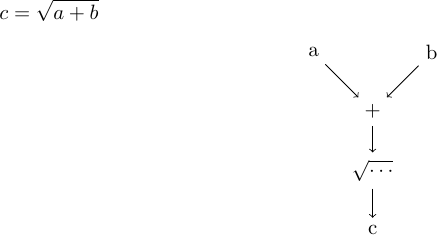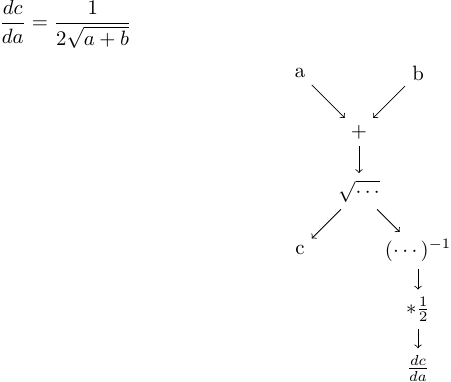DAC provides a C++ library to express and perform algebraic computations on computational graphs. The computational graphs are created through a C++ interface, which then generates C-code to perform the actual computations.
As yet it is restricted to Linux use only. This limitation, however, is only due to the use of pthreads and will be improved upon in the future.
The library is currently in an early proof of concept state, with many interface changes ahead. It contains a plethora of open ends, where it's not yet clear how to design a scalable architecture for certain problems. The current strategy is to experiment by implementing some use-cases to get a feeling for this.
- The top level makeRun.sh compiles & executes all unit tests & examples and checks that they work as intended.
dac$ ./makeRun.sh
Running unit tests...Passed!
Running examples:
Running solar system...Passed!
Everything passed!- Check out the solar system example. Start by following the suggestions in the README.
DAC focuses on numerical problems requiring many algebraic operations, where the overhead of a function call for such an operation may be neglected. Specifically, problems where the same operations on large arrays are run many times, as is the case in typical optimization / simulation problems (e.g. machine learning, any physical simulation, ...).
If only a few dozen vector/matrix operations in a couple of dimensions is required, one will be better off using Eigen or some BLAS-like library.
- Automatic differentiation
- Global optimization over whole computational graph
- Everything is a n-Tensor, greatly simplifying derivative handling. In particular, it enables taking more than the first derivative in a consistent fashion, e.g. derivative of a 2-Tensor = Matrix is a 3-Tensor and so forth (notice, that DAC uses the convention that derivative indices are added in the front):

- Easy access to special objects (e.g. Kronecker delta, ...) with efficient implementations for operations using them.
- Interface is closer to standard mathematical literature, e.g. one defines a vector space and may then declare something an element of that space
- This enables group representations on that space which in turn optimize numerics: E.g. the product of rotation matrices is a rotation matrix, rotation matrices are orthogonal, ...
- The generatated code which performs the actual computations is C-code with no external libraries and may thus be run on any hardware
- Create a program for the computational graph & code generation using this library. In the examples and unit tests of this project, this is done inside the "Generator" folders.
- Have that program generate code into some library folder for the...
- Create a program which compiles & executes the code generated in the last step. In the examples and unit tests of this project, this is done inside the "Executor" folders.
- Inside that program, set callback functions to interface to the graph, to e.g. get the output of a node whenever it was executed
A computational graph is a graph where each nodes either holds a variable or an operation on variables, e.g. to express
Why go through this trouble? It enables generating symbolic derivatives by using the chain rule on the graph ("Backpropagation") and global optimization, e.g.
Notice, that the derivative output does not recalculate the sum and square root, but uses the node already existing - that would be an example of global optimization.
Furthermore, graphs make for easy parallelization, that is destribution of work among multiple processors.
- The compiler has an easier time optimizing the code, because many things which would be variables are constants and branching can be reduced to the absolute minimum
- Enabes using e.g. feedback directed optimization (see solar system example)
- Generating custom code offers (theoretically) the fastest possible solution
- Makes the code less complicated
- Enables customization, e.g. loop-unrolling according to how many floating point units, ...
- Close to hardware
- Supported on all architectures. In particular embedded.
- Convolutional neural network operations (ongoing)
- Partial differential equations: Current ultimate goal of this project is to provide a framework where (physical) PDEs may be solved geometrically, based on their formulation in the language of differential forms. This will require some form of triangulation and operations thereon. It's going to take a while.
- Vector public vectorSpace?
- Make more use of constructors rather than setting variables of object directly
- Simplify equations, e.g. a + a + a = 3 * a, a * a / a = a, ...
- Create Doxygen documentation of user interface
- Introduce some coding convention
- The files copied from The Linux Programming Interface should either be replaced or used more consistently
- Include gcov with unitTests and generate coverage.
- Restructure code: Interface user -> graph -> code generator should be well-defined.
- Create some clean interface to jobPool
- NodeRef::StoreIn offers no protection from overwriting data not yet consumed by other nodes
- Better solution for control transfer: Current solution only works if there is a single root to the while part.
- For debugging, NodeRefs should implement PrintInfo()
- Get rid again of homomorphism?
- Every contraction/product with kronecker makes vector sparse
- Make vector properties a map<property, const void *>
- Error cnt in code generator accessible to user.
- Put initializer values into separate header? they can become very long.
- _space should be private. And offer a function which returns a const pointer/ref to it.
- It's weird that VectorSpace::Vector rather than VectorSpace::Element.
- Rename Vector -> Tensor? Imagine someone using namespace std and then Cpp-Vectors.
- Rethink that vector space pointer business.
- Introduce "scaling" to vectors, so that e.g. for scalar multiplication not the whole vector needs to be multiplied
- Introduce optimized memory handling: Not every node needs to be statically allocated. Memory may actually be globally optimized on graph
- How to deal with special vectors? E.g. starting with Kronecker? They all require special operator-implementation. The current solution isn't scalable.
- To enable DAC on non-unix single-core targets, it should be possible to build without pthreads.
- Check that all printf of floats uses all floating digits in code generator!

